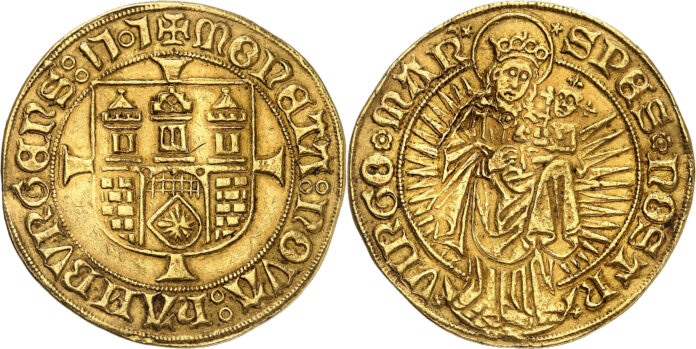The Top Ten of Künker’s Rarity Auction Sale
Actually, this is something that should make us think: we no longer need on-site public auctions to achieve great results. This fact was demonstrated by Künker in its first auction sale in the 50th anniversary year of Künker. Traditionally, the flagship auction at the end of January takes place with large international participation during the World Money Fair in Berlin. This year, Künker had to hold the auction in a small circle of employees due to the current Corona restrictions. Nevertheless, all Künker customers had the chance to bid in the way they prefer, be it via written note, phone or live bidding at the computer. The result speaks for itself. 721 lots realized a total of 9.3 million euros. And all coins that made the top ten were sold for a price in the six-digit range. An amazing start of the anniversary year!
Nevertheless, Andreas Kaiser points out: “An auction is the best opportunity for us to meet our customers. As soon as possible, Künker auction sales will take place in the real world once again.” And Ulrich Künker adds: “It’s really nice that there are all these virtual possibilities, however, it’s something different to be present in the auction room and take part in the bidding process. We already want to invite you to the on-site auctions we will hold as soon as we are allowed to do room auctions again.”
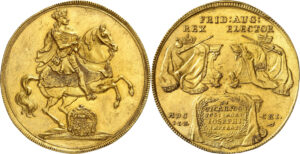
10th Place
The 10th place was awarded to two coins with a hammer price of 100,000 euros: the off-metal strike in gold of a 1711 Saxon reichstaler commemorating the vicariate of Augustus the Strong weighing 8 ducats realised 100,000 euros. This is probably the only specimen that ever appeared on the market. You will learn more about the historical background of this coin in this article because Künker’s auction 346 did not only contain an 8 ducat piece but also a 10 ducat piece made with the same dies. It ranked higher in the top ten, also because its quality was a little better than that of the 8 ducat piece.
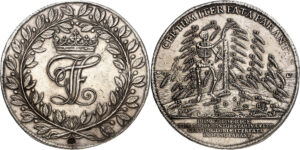
A löser of 10 reichstalers commemorating the death of John Frederick of Brunswick-Calenberg on also realized 100,000 euros. The successor of John Frederick had the coin design, which seems rather enigmatic to us today, made in coordination with the decoration of the funeral. We know from a volume illustrated with numerous copper engravings chronicling the funeral of this prince that such lösers were given to high-ranking visitors on the occasion of the funeral ceremony. You can learn more about the historical background on our website.
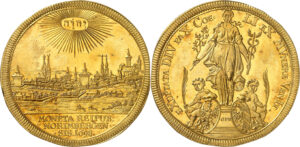
9th Place
This magnificent Nuremberg 5 ducat piece of 1698 jumped from an estimate of 40,000 euros to a hammer price of 120,000 euros. There are three reasons for this impressive result. First, the coin is of excellent provenance. It comes from the Christoph Bernoulli Collection, which was sold in 1996 at Münzen und Medaillen AG in Basel. From there it came directly to the collection of a connoisseur and art lover. Moreover, the piece features a city view, which is a particularly popular motif especially among non-German collectors. Last but not least, the 5 ducat piece was graded MS63 by NGC. Especially in times when viewing is not possible, international customers like to rely on the work of independent grading institutes. This too seems to be a sign of a time, in which it is no longer possible to assure yourself of the quality of the coin you’d like to bid on in person or through a trusted coin dealer.
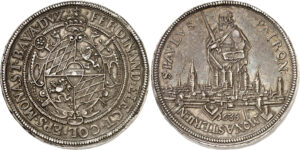
8th Place
A 1638 triple reichstaler minted by bishop Ferdinand of Bavaria for Münster sold for 140,000 euros. Ferdinand of Bavaria, the son of the Bavarian Duke William V and brother of Elector Maximilian I of Bavaria, was one of the most powerful prince-electors of his time: he was Elector and Archbishop of Cologne, Duke of Westphalia as well as Prince-Bishop of Hildesheim, Liège, Münster and Paderborn. This triple reichstaler combines the Bavarian coat of arms with coronet, crosier and sword on the obverse; the reverse features a splendid view of the fortified Münster, above it the patron saint St. Paul.
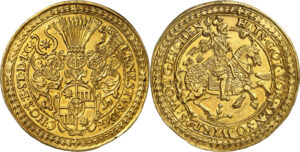
7th Place
An extremely rare 10 ducat piece of Ernst III of Holstein-Schauenburg came in 7th with a result of 190,000 euros. This makes it the most expensive coin of Holstein-Schauenburg sold in the last 20 years. The reverse of the coin, which was minted in Altona, shows Count Ernst III in full armour with his motto: If God has foreseen it, it will be good.
If you want to know more about why a little count had enough money to initiate such extensive minting activities, you can find it out in the article “Gold From Coal and Stone: Ernst III of Holstein-Schauenburg”.
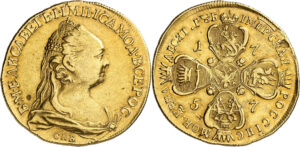
6th Place
The story of this coin was covered by many major German media outlets such as Der Spiegel and WELT: While tidying up his flat, a 70-year-old Berliner found a coin left to him by his father, who had been born in Saint Petersburg. He offered the coin to two coin dealers, one of them believed the piece to be a counterfeit and the other offered him 900 euros for it. When the Berliner saw a similar piece on Künker’s website and therefore consigned the coin to the Osnabrück auction house, Künker’s expert immediately realized what a rarity he was looking at: it was an extremely rare Russian 10 rouble piece from 1757. The dies had been made by the Swiss medallist Jacques-Antoine Dassier. And there is something truly unusual about the item: a collector’s hallmark proves that this coin had once been part of the collection of Count Emmerich Hutten-Czapski.
Connoisseurs honored the rarity of the piece: the coin was sold for 210,000 euros. The delighted heir wants to use the money to pay off the mortgage on his home.
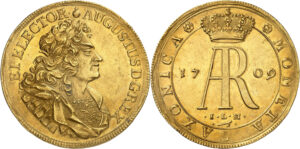
4th Place
The 4th place was awarded to two coins with a hammer price of 220,000 euros: both “winners” are from Saxony and were minted by Augustus the Strong.
A sixfold ducat of 1709, minted in Dresden with the dies of a taler, climbed from 100,000 to 220,000 euros. The coin’s obverse depicts a splendid baroque portrait of Augustus the Strong, the reverse shows a monograph with the crown of the Polish king. And there’s a good reason for it. In the year the coins were minted, Augustus the Strong re-established his rule over Poland: his rival Stanislaus I Leszcynski lost the support of Charles XII of Sweden, who had made him king of Poland, with the Battle of Poltava.
There is probably only one specimen of this gold rarity, whose provenance can be traced back to 1924.
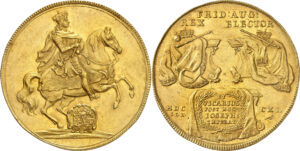
A 10fold gold ducat minted with the dies of the 1711 reichstaler bears testimony to the fact that Augustus the Strong, King of Saxony, held the office of imperial vicar in that very year.
The imperial vicariate was one of the most prestigious offices in the Holy Roman Empire. The Golden Bull of 1356 stipulated that the Saxon Elector was to share the imperial vicariate with the Count Palatine of the Rhine in the time between the death of an emperor and the coronation of its successor. For this purpose, the empire wasn’t divided on the basis of geography but on the basis of the applicable law: the Count Palatine controlled the territories of Frankish law, the Saxon King the territories of Saxon law.
Joseph I had died on 17 April 1711. His brother Charles VI was not elected king of the Holy Roman Empire by the electors until 12 November 1711 and was crowned emperor on 22 December in Frankfurt. During the months of Augustus the Strong’s activities as imperial vicar, he had an extensive amount of coins issued including the extremely rare off-metal strikes in gold of the reichstaler weighing 8 and 10 ducats. We have already presented the 8 ducat piece on place 10. It sold for 100,000 euros, i.e. less than half of what the coin weighing 10 ducats realized. It achieved a result of 220,000 euros, which is also due to the fact that it is of slightly better quality than the other piece. By the way, there are two specimens of the 10fold ducat, but only one on the market.
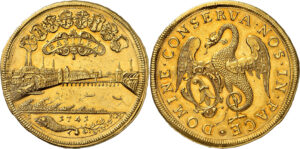
2nd Place
The second place was awarded twice to two coins that realized 280,000 euros each. First we present the impressive gold issue from Basel that achieved such a high result. It was also made with the dies of a taler, however, it was issued at the impressive weight of 20 ducats, i.e. 68.94 g. Just like the Nuremberg issue on place 9, the coin with the magnificent city view comes from the Christoph Bernoulli Collection.
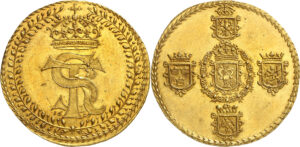
2nd Place
A Polish 10 ducat piece from Bromberg, minted by Sigismund III in 1629, also realized 280,000 euros – even though it had an estimate of 75,000 euros. Only two specimens of this splendid coin are known, one of which is kept in a museum. We only know of one time when such a piece was auctioned off, and that was more than one and a half centuries ago. A 10 ducat piece like this one was sold at the J. Bermann & Sohn auction under the title “Verzeichnis einer großen und sehr gewählten polnischen Münz- und Medaillen Sammlung” (Index of a large and very selected Polish coin and medal collection) on 1 April 1850 in Vienna as lot No. 887. However, no one knows whether the specimen offered there was the one that is kept in the Hutten-Czapski Museum today or the one auctioned off at Künker. As was customary at the time, the catalogue neither depicts the coin nor indicates its weight.
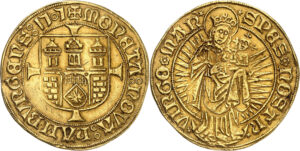
1st Place
Thanks to a result of 450,000 euros, the 6fold gold gulden from Hamburg minted in 1505 is not only the most expensive coin of Künker’s Rarity Auction Sale but also the most expensive coin of Hamburg. This is due to the fact that it is not only the first Hamburg multiple gold coin, but the first multiple gold coin of the entire German area. In 1930, Felix Schlessinger already described the piece – a unique specimen – as a “showpiece of the first rank!”, and he was certainly right.
The last time this specimen appeared on the market was in 2007. Even back then it achieved an impressive result of CHF 180,000 and was the most expensive coin of auction No. 100 of LHS, the successor to the renowned numismatic department of Bank Leu. Despite the high price at the time, the buyer made a good investment by purchasing it.
Congratulations to all successful bidders and to all consignors. The prices demonstrate how strong the market currently is, whether that be in spite of or because of Corona.
All the results can be found on the Künker website. If you’re interested in a consignment, please contact Künker’s customer support at Nobbenburger Straße 4a, 49076 Osnabrück, Germany; phone: +49 541 962020, fax: +49 541 9620222; or via e-mail.
Upcoming auctions:
22 to 26 March 2021 Spring Auction Sales
28 June to 2 July 2021 Summer Auction Sales
27 September to 1 October 2021 Fall Auction Sales



